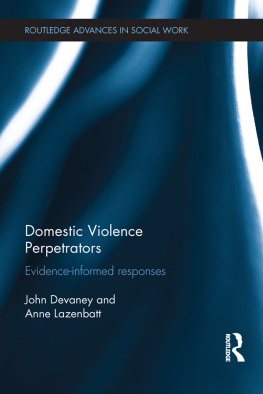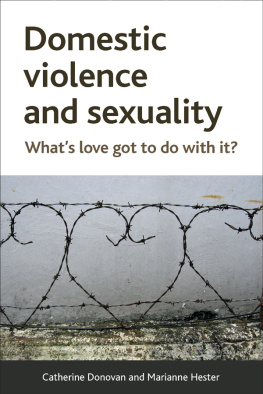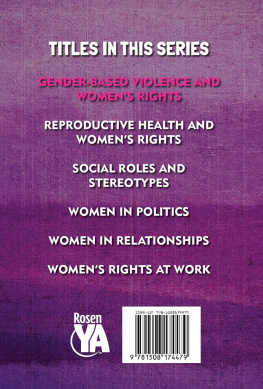Breaking
the Silence
The Church Responds
to Domestic Violence
Breaking
the Silence
The Church Responds
to Domestic Violence
Anne O. Weatherholt

Copyright 2008 by Anne O. Weatherholt
All rights reserved. No part of this book may be reproduced, stored in a retrieval system, or transmitted in any form or by any means, electronic or mechanical, including photocopying, recording, or otherwise, without the written permission of the publisher.
Unless otherwise noted, the Scripture quotations contained herein are from the New Revised Standard Version Bible, copyright 1989 by the Division of Christian Education of the National Council of Churches of Christ in the U.S.A. Used by permission. All rights reserved.
Morehouse Publishing, 4775 Linglestown Road, Harrisburg, PA 17112
Morehouse Publishing, 445 Fifth Avenue, New York, NY 10016
Morehouse Publishing is an imprint of Church Publishing Incorporated.
Cover design by Brenda Klinger
Interior design by Ronda Scullen
Library of Congress Cataloging-in-Publication Data
Weatherholt, Anne O.
Breaking the silence : the church responds to domestic violence /
Anne O. Weatherholt.
p. cm.
Includes bibliographical references.
ISBN 978-0-8192-2320-3 (pbk.)
ISBN 978-0-8192-2694-5 (ebook)
1. Family violenceReligious aspectsChristianity. 2. Church work with problem families. 3. Church work with abused women.
I. Title.
BV4438.5.W43 2008
261.8'327dc22
2008023751
Contents
I wish to thank the following persons who were instrumental in helping me take a small manuscript and turn it into a useful resource:
The Rev. Wes Wubbenhorst, Youth Missioner in the Episcopal Diocese of Maryland, who found a way to draw attention to the need for this book;
Dian Nelson, my dear friend, who read the first draft, corrected many errors, gave me lots of suggestions from the local paper and World Wide Web, and helped me learn how to document my research;
To my family, Allan my husband, my boys Daniel and Stephen, who quietly and patiently went about their lives in our home while I wrote, and always showed interest and pride for what I was doing;
To the director and staff at CASA (Citizens Assisting and Sheltering the Abused) in Hagerstown, those on the front line who provided answers to my many technical questions about helping the victims of domestic violence;
The staff at Church Publishing who were so gracious and encouraging;
And to my colleagues in ministry who kept saying this book was greatly needed.
Every day, women from all walks of life are intimidated, beaten, and sexually assaulted by their intimate partners. You already know someone who has felt the terror and intimidation of domestic violence. According to a 2006 Harris Poll quoted on the National Domestic Violence Hotline Statistics in June 2008, approximately 33 million or 15% of all U.S. adults admit that they were a victim of domestic violence. Furthermore, six in ten adults claim that they know someone personally who has experienced domestic violence. Abusers come from all socio-economic levels, all occupations, all ethnic and religious groups. Often, their victims are unwilling or feel unable to leave their homes or their abusive partners.
Unlike many crimes that the general public recognizes as illegalbreaking and entering, assault, robbery, rape, drunk drivingdomestic violence is a crime, usually hidden, that often goes unrecognized. Even when people may suspect that abuse is taking place, they may not know how to respond, or may feel it is none of their business. Domestic violence takes place in private between two persons who are supposed to love one another. The extent of the abuse and the time period over which it occurs are often underestimated by those in the situation and by those who may have suspected that abuse is taking place. Because it happens in private, in the sanctity of the home, abuse is difficult to prevent, to identify, to stop, and to prosecute.
My husband and I are Episcopal priests and state police chaplains. We keep police scanners on in our home and offices, and almost every day we hear law enforcement officers called to incidents of domestic violence. Many of the calls are frightening, with sounds of yelling in the background and reports of the presence of weapons, and the situations are fraught with danger for the victims and the law enforcement officers. As we counsel these frontline officers after a critical incident, we hear their frustration with this ongoing and pernicious behavior. But we have also counseled those in abusive relationships in our churches, families for whom we have performed weddings and baptisms, and we serve on community boards for agencies that assist victims of domestic abuse. When I was first ordained, I performed a wedding for a young couple in the chapel of the college where I was serving as chaplain. About a year later, I ran into the wife in a grocery store and was stunned to find that they were divorced. She told me she was all right now, but that her husband had beat her after they were married. She told me that before they were married, he used to hit the dog. Soon thereafter, I joined a group of women meeting to begin the process for establishing a shelter for abused women in Frederick, Maryland. That shelter is there today.
The roots of domestic violence lie deep within a society that still values men more than women and teaches men to view women as inferior and sexual objects. Most of those abused are women, but men can also be abused by partners who intimidate, insult, and debase them, and men may suffer physical abuse, as well. In order to avoid awkward and cumbersome phrasing in this book, we have sometimes used the male pronoun for the abuser and the female for the one who is abused, but this is not intended to exclude or diminish the experiences of male victims. Please see the section specifically for male victims in .
The flames of the violence are fanned by a culture that desensitizes us to feelings of revulsion and deadens our reactions by frequent exposure to violent acts that we see all around us on television, movies, and via the World Wide Web. History shows us that the faith community is also culpable in denying or supporting domestic abuse through traditional teachings that empower men and weaken women, and through an emphasis on upholding the doctrines of marriage and family while overlooking the behavior that is actually demonstrated in the home. People who are abused hesitate to turn to their church, fearing condemnation or the possibility that their minister will advise them to return home and try harder to make the marriage work. The faith that is supposed to offer hope and freedom to those in captivity is empty for those who are told that suffering is redemptive, and vows are unbreakable.
This book was written as a response to several Resolutions from the General Convention of the Episcopal Church in 1988 and 2000. Resolution 2000-C025 reads in part that the 73rd General Convention calls upon every
While most of us tend to shy away from this subject and deny its pervasive reality, learning about domestic violence and reaching out to help the victims are not sad and depressing tasks. Barbara Reed Martin, current CEO of Heartly House, Inc. in Frederick, Maryland, an emergency shelter, speaks with great hope about work with victims of domestic violence. She says, When women ask for help, life-transforming work happens.
Life-transforming work is the mission of the church, and when a faith community is educated, challenged, and involved in the issue of domestic violence, life-transforming work will happen. No single resource can provide all the answers. This book may help you get started, but the written word is only a tool to be used by compassionate people who act on their baptismal vows to respect the dignity of every human being and reach out with their hands, their time, and their resources to lift up those who have been battered down by domestic violence.
Next page






